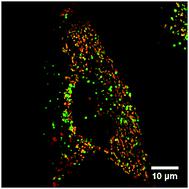当前位置:
X-MOL 学术
›
RSC Chem. Biol.
›
论文详情
Our official English website, www.x-mol.net, welcomes your
feedback! (Note: you will need to create a separate account there.)
Strategies to promote permeation and vectorization, and reduce cytotoxicity of metal complex luminophores for bioimaging and intracellular sensing
RSC Chemical Biology ( IF 4.2 ) Pub Date : 2021-5-5 , DOI: 10.1039/d1cb00049g Lorcan Holden 1 , Christopher S Burke 1 , David Cullinane 1 , Tia E Keyes 1
RSC Chemical Biology ( IF 4.2 ) Pub Date : 2021-5-5 , DOI: 10.1039/d1cb00049g Lorcan Holden 1 , Christopher S Burke 1 , David Cullinane 1 , Tia E Keyes 1
Affiliation

|
Transition metal luminophores are emerging as important tools for intracellular imaging and sensing. Their putative suitability for such applications has long been recognised but poor membrane permeability and cytotoxicity were significant barriers that impeded early progress. In recent years, numerous effective routes to overcoming these issues have been reported, inspired in part, by advances and insights from the pharmaceutical and drug delivery domains. In particular, the conjugation of biomolecules but also other less natural synthetic species, from a repertoire of functional motifs have granted membrane permeability and cellular targeting. Such motifs can also reduce cytotoxicity of transition metal complexes and offer a valuable avenue to circumvent such problems leading to promising metal complex candidates for application in bioimaging, sensing and diagnostics. The advances in metal complex probes permeability/targeting are timely, as, in parallel, over the past two decades significant technological advances in luminescence imaging have occurred. In particular, super-resolution imaging is enormously powerful but makes substantial demands of its imaging contrast agents and metal complex luminophores frequently possess the photophysical characteristics to meet these demands. Here, we review some of the key vectors that have been conjugated to transition metal complex luminophores to promote their use in intra-cellular imaging applications. We evaluate some of the most effective strategies in terms of membrane permeability, intracellular targeting and what impact these approaches have on toxicity and phototoxicity which are important considerations in a luminescent contrast or sensing agent.
中文翻译:

促进渗透和矢量化并降低金属络合物发光体细胞毒性的策略,用于生物成像和细胞内传感
过渡金属发光体正在成为细胞内成像和传感的重要工具。它们对于此类应用的假定适用性早已得到认可,但较差的膜渗透性和细胞毒性是阻碍早期进展的重大障碍。近年来,已经报道了许多克服这些问题的有效途径,部分灵感来自制药和药物输送领域的进步和见解。特别是,生物分子以及其他不太天然的合成物种的结合,来自一系列功能基序,赋予了膜渗透性和细胞靶向性。这些基序还可以降低过渡金属配合物的细胞毒性,并为规避此类问题提供了宝贵的途径,从而产生了用于生物成像、传感和诊断的有前景的金属配合物候选物。金属络合物探针渗透性/靶向性的进步是及时的,同时,在过去的二十年里,发光成像领域也取得了重大的技术进步。特别是,超分辨率成像非常强大,但对其成像造影剂提出了很高的要求,而金属络合物发光体通常具有满足这些要求的光物理特性。在这里,我们回顾了一些与过渡金属络合物发光团缀合的关键载体,以促进它们在细胞内成像应用中的使用。我们评估了一些在膜渗透性、细胞内靶向方面最有效的策略,以及这些方法对毒性和光毒性的影响,这些是发光对比剂或传感剂的重要考虑因素。
更新日期:2021-05-11
中文翻译:

促进渗透和矢量化并降低金属络合物发光体细胞毒性的策略,用于生物成像和细胞内传感
过渡金属发光体正在成为细胞内成像和传感的重要工具。它们对于此类应用的假定适用性早已得到认可,但较差的膜渗透性和细胞毒性是阻碍早期进展的重大障碍。近年来,已经报道了许多克服这些问题的有效途径,部分灵感来自制药和药物输送领域的进步和见解。特别是,生物分子以及其他不太天然的合成物种的结合,来自一系列功能基序,赋予了膜渗透性和细胞靶向性。这些基序还可以降低过渡金属配合物的细胞毒性,并为规避此类问题提供了宝贵的途径,从而产生了用于生物成像、传感和诊断的有前景的金属配合物候选物。金属络合物探针渗透性/靶向性的进步是及时的,同时,在过去的二十年里,发光成像领域也取得了重大的技术进步。特别是,超分辨率成像非常强大,但对其成像造影剂提出了很高的要求,而金属络合物发光体通常具有满足这些要求的光物理特性。在这里,我们回顾了一些与过渡金属络合物发光团缀合的关键载体,以促进它们在细胞内成像应用中的使用。我们评估了一些在膜渗透性、细胞内靶向方面最有效的策略,以及这些方法对毒性和光毒性的影响,这些是发光对比剂或传感剂的重要考虑因素。











































 京公网安备 11010802027423号
京公网安备 11010802027423号